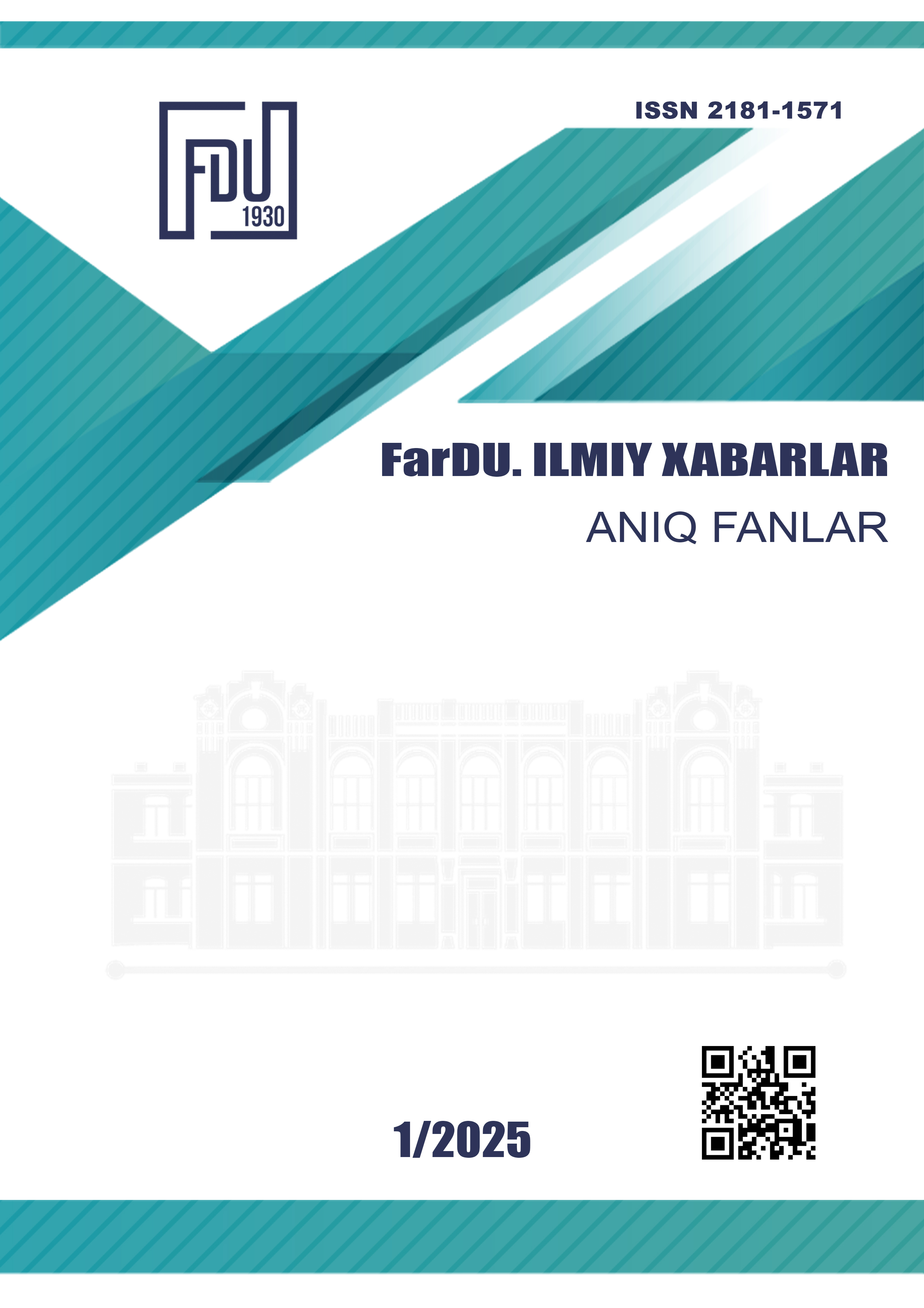SYNTHESIS AND STUDY OF THE COMPLEX COMPOUND OF N-(1H-1,2,4-TRIAZOL-YL) ACETAMIDE WITH ZINC (II) CHLORIDE
Keywords:
N-(1H-1,2,4-triazol-3-yl)acetamide, zinc chloride, ligand, infrared spectroscopy, scanning electron microscope, X-ray structural analysis, thermal analysis.Abstract
Methods of synthesizing complex compounds of N-(1H-1,2,4-triazol-yl) asetamide with Zn(II) chloride was developed, and the composition and structure of the synthesized complex compounds were studied using modern physical and chemical research methods. It was found that the ligand is coordinated through the second nitrogen of the triazole ring and the oxygen atoms of the acetamide group in the reactions of N-(1H-1,2,4-triazol-yl) asetamide complex formation. [Zn(L)2(H2O)2]Cl2 crystals have a monoclinic molecular structure, in which the metal atom forms a six-membered chelate ring with the nitrogen of the triazole ring and the oxygen atoms of the acetamide group and the oxygen atoms of water. In the [Zn(L)2(H2O)2]Cl2 complex, the bond lengths of Zn1-N3, Zn1-O1 and Zn1-O2 are 1.937, 2.024 Å and 2.40 Å, and the angles of N3-Zn1-N4 are 91.32°(19). The largest angular values belong to the angles of N3-Zn1-N3, O1-Zn1-O1 and N4-Zn1-N4, which are 180.0°. The coordination number of the central copper atom is six and it is hybridized in the sp3d2 state. Intermolecular hydrogen bonds are formed between the hydrogen atom of the imine group of the 3-acetylamino-1,2,4-triazole ligand and the oxygen of water. The positive charge of the zinc ion is compensated by the chloride acid ligand in the anionic state.
References
. Zhang H.Z., Gan L.L., Wang H., Zhou C.H.. New Progress in Azole Compounds as Antimicrobial Agents. Mini Rev. Med. Chem., 17, 122 (2017). DOI: 10.2174/1389557516666160630120725
Zhang S., Xu Z., Gao C., Ren Q., Chang L., Lv Z., Feng L. Eur. Triazole derivatives and their anti-tubercular activity. // European Journal of Medicinal Chemistry.–2017.–V.138. –P. 501-513. doi.org/10.1016/j.ejmech.2017.06.051
Hanif M., Chohan Z.H. Design, spectral characterization and biological studies of transition metal(II) complexes with triazole Schiff bases Spectrochim. // Acta A Mol. Biomol. Spectrosc. –2013.–V. 104.–P. 468-476. doi:10.1016/j.saa.2012.11.077
Kashyap A., Silakari O. In Key Heterocycle Cores for Designing Multitargeting Molecules. // Elsevier. Amsterdam. –2018. –V. 9. –P. 323-342
M.I.Barmin., V.P.Kartavykh., E.A.Korolev., I.D.Tugai., A.N.Grebenkin., V.V.Mel’nikov. Acylation of Amino-1,2,4-triazoles. Russian Journal of General Chemistry 71, 557-566 (2001)
А. В. Васильев, Е. В. Гриненко, А. О. Щукин, Т. Г. Федулина Инфракрасная спектроскопия органических и природных соединений. 2007. Ст-16.
Накамото К. ИК спектры неорганических и координационных соединений. - М.: Мир. - 1996. - 206 с.
Тарасевич Б.Н., ИК спектры основных классов органических соединений. МГУ имени М.В.Ломоносова, химический факультет, кафедра органической химии. Москва 2012
Топор Н.Д., Огородова Л.П., Мельчакова Л.В. Термический анализ минералов и неорганических соединений. - М.: Изд-во МГУ, –2005.
Кукушкин Ю.Н., Ходжаев О.Ф., Буданова В.Ф., Парпиев Н.А. Термолиз координационных соединений. -Тошкент: Фан, –1986
Л.Б.Калмқков, Н.Е.Дмитриева., Сканируюўая электронная микроскопия и рентгено-спектралънқй анализ неорганических материалов. - Москва: 2017
Downloads
Published
Issue
Section
License
Copyright (c) 2025 Scientific journal of the Fergana State University

This work is licensed under a Creative Commons Attribution-NonCommercial-NoDerivatives 4.0 International License.
How to Cite
Most read articles by the same author(s)
- , , HISTORICAL AND ECOLOGICAL ASPECTS OF RATIONAL USE AND PROTECTION OF NATURE , Scientific journal of the Fergana State University: No. 1 (2024): FarDU ilmiy xabarlar jurnali ilova to‘plam (GEOGRAFIYA)
- , THE ROLE OF THE KOKAND LITERARY ENVIRONMENT IN THE FORMATION OF NADIR'S ARTISTIC WORLD VIEW , Scientific journal of the Fergana State University: No. 2 (2023): Scientific journal of the Fergana State University (Social humanities sciences)
- , VIEWS OF TURKESTAN JADIDS ON WOMEN’S EDUCATION , Scientific journal of the Fergana State University: No. 4 (2024): FarDU.Ilmiy xabarlar jurnali (Aniq va tabiiy fanlar)
- , , , , , , PROSPECTS FOR USING THE CHEMICAL MELIORATION METHOD FOR WASHING SALTS CONTAINED IN SALINE SOILS IN THE NAVOI REGION , Scientific journal of the Fergana State University: No. 1 (2024): FarDU.Ilmiy xabarlar jurnali (Aniq va tabiiy fanlar)
- , , , ANALYTICAL DETERMINATION OF Co3+ CATION WITH GOSSIPOL-2-AMINO-4-METHYLPYRIDINE , Scientific journal of the Fergana State University: No. 3 (2023): FarDU ilmiy xabarlari jurnali (Aniq va tabiiy fanlar)
- Raximov Quvvatali Ortikovich, Mamatova Zilola Xabibulloxonovna, Tazhikenova Nurzhanar Kabikenkizi, COMMON PHISHING ATTACKS IN KAZAKHSTAN AND WAYS TO PROTECT CITIZENS FROM INTERNET SCAMMERS , Scientific journal of the Fergana State University: No. 3 (2024): FarDU.Ilmiy xabarlar jurnali (Aniq va tabiiy fanlar)
- , , , , , SYNTHESIS 3,3'-DISULFANEDIYLBIS(1H-1,2,4-TRIAZOL-5-AMINE) , Scientific journal of the Fergana State University: No. 3 (2022): Scientific journal of the Fergana State University
- , , RESEARCH OF THE DENSITY BY HYDROSTATIC WEIGHT METHOD OF POLYMER COMPOSITE MATERIALS BASED ON RECYCLED POLYETHYLENE WASTE , Scientific journal of the Fergana State University: No. 4 (2024): FarDU.Ilmiy xabarlar jurnali (Aniq va tabiiy fanlar)
- , , CONCEPTUAL FRAMEWORK FOR GEOGRAPHICAL RESEARCH OF ENCLAVE AREAS , Scientific journal of the Fergana State University: No. 1 (2024): FarDU ilmiy xabarlar jurnali ilova to‘plam (GEOGRAFIYA)
- , , STUDYING ETHNO-LANGUAGE CHARACTERISTICS OF POPULATION BEHAVIOR BASED ON SOCIOLOGICAL SURVEYS , Scientific journal of the Fergana State University: No. 1 (2024): FarDU ilmiy xabarlar jurnali ilova to‘plam (GEOGRAFIYA)

